|
|
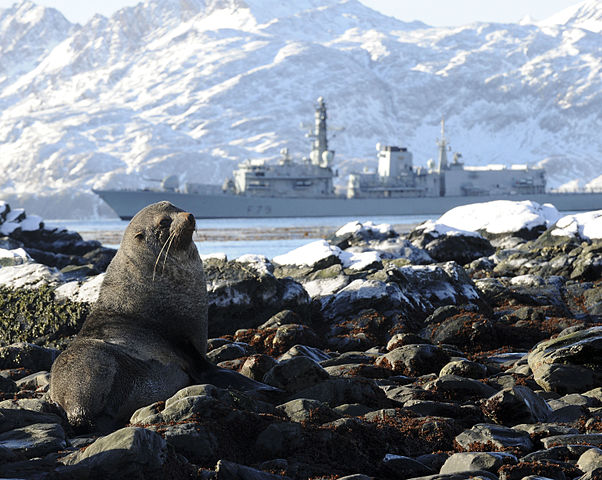
While no one was paying attention, a Russian ship exploring Antarctica claims it has found oil and gas deposits that are ten times larger than the North Sea. Presumably quite a lot of countries would find this very interesting. At the moment Antarctica is supposedly protected by a piece of paper, but those who want to keep something so valuable to themselves will be needing more than cellulose.
It could take some fossil fuels to protect these fossil fuels
Hard to see any nation keeping control of this oil and gas field using sailing boats, solar powered ships and missiles running on palm oil.
Johnathon Leake, Telegraph
Russia has found vast oil and gas reserves in the Antarctic, much of it in areas claimed by the UK.
The surveys are a prelude to bringing in drilling rigs to exploit the pristine region for fossil fuels, MPs have warned.
Reserves totalling 511bn barrels of oil – about 10 times the North Sea’s entire 50-year output – have been reported to Moscow by Russian research ships, according to evidence given to the Commons Environment Audit Committee (EAC) last week.
It follows a series of surveys by the Alexander Karpinsky vessel, operated by Rosgeo – the Russian agency charged with finding mineral reserves for commercial exploitation.
The total extracted from the North sea up until 2014 was about 42 billion barrels of “oil equivalent”. Green fanatics would be horrified to think of all the emissions that might be unleashed, but 3 billion cold people in China, Russia, India and Japan might have a different view.
It’s hard to believe no one has staked a claim on Marie Byrd Land. We’re they just too busy to attend the meeting?
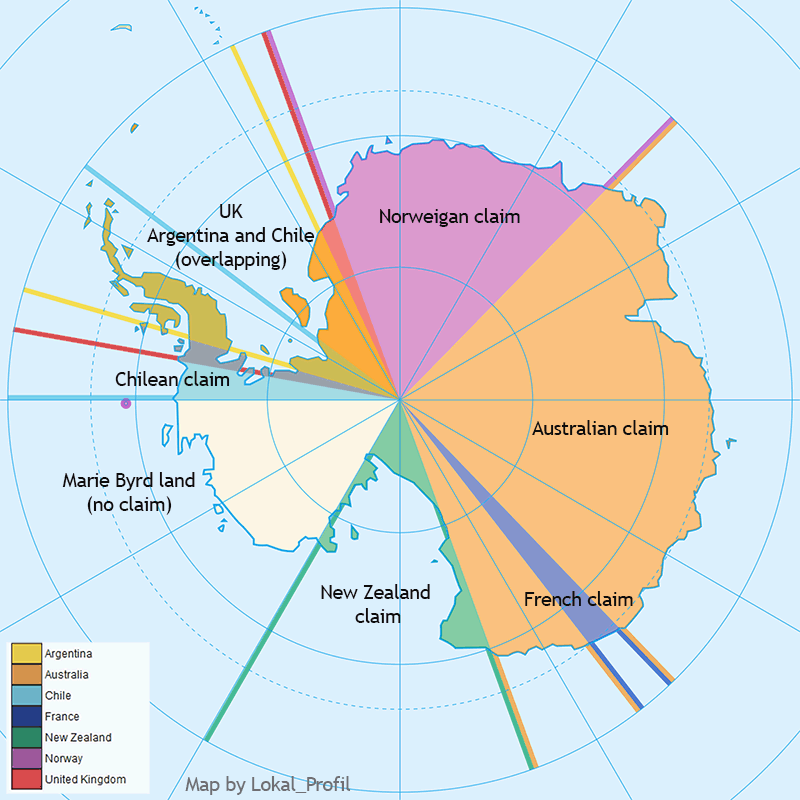
Russia claims that its boat was just doing scientific research (just like those Japanese whalers were).
At least a part of the UK government apparently found out about this when a South African newspaper published a story on it. (Who needs intelligence when you can read the Daily Maverick?)
The EAC [Environment Audit Committee] decided to challenge the Foreign Office’s management of the UK’s Antarctic interests following reports in the Daily Maverick, a South African online journal, which discovered Moscow’s activities after its survey ship docked in Cape Town.
The British government has officially said they believe the Russians, but a few in the British government are skeptical. (From the Daily Maverick)
[Anna McMorrin, a Labour MP on the polar audit sub-committee] asked FCDO Under-Secretary David Rutley… if he was “aware” of the Rosgeo vessels, under US sanctions since February, and how the UK was to respond at the annual Antarctic Treaty consultative meeting (ATCM) in India from May 20 to 30.
The under-secretary defended Russia’s “repeated assurances” at ATCMs “that these activities are for scientific purposes”.
A sceptical McMorrin asked Rutley if he was “content to believe Russia when they say they’re just undertaking scientific action”. The Labour MP also quoted expert testimony to the committee, stressing that leading polar geopolitician Professor Klaus Dodds had flagged the “current Russian activity” and its possible “prospecting” links as “troubling”.
“There is a worry that Russia is collecting seismic data that could be construed to be prospecting rather than scientific research. And, if such, does this signal a potential threat to the permanent ban on mining,” asked Dodds, of Royal Holloway, University of London, “with knock-on implications for the integrity of the protocol in its entirety?”
Suddenly people might start paying attention to Antarctica.
hat tip to @TomNelson and @NetZeroWatch
______________________________________
For the record, the dispute between the UK and Argentina goes back a long way.
Photo: LA(Phot) Ian Simpson of the HMS Portland in South Georgia in 2010 on Wikimedia
10 out of 10 based on 13 ratings
7.8 out of 10 based on 4 ratings

By Jo Nova
Renewable billionaires would be crazy if they weren’t funding “Environmental Activists”
Nick Cater points out one mysterious charity, the Sunrise Project Australia had a “revenue” of $73.8 million* dollars last year and we don’t know where that came from.
Let’s say you made a fortune from Big-Government subsidies and rigged market rules — what would stop you pouring some of those parasitic profits right back into fake environmentalists groups to help “your favourite” politicians win? It has the added bonus that when your wind turbines chop up eagles or deafen the dolphins no one says a word. The same sell-out environmental groups would .. do nothing at all. Mum’s the word! Which is exactly what Greenpeace and the WWF seem to do — nothing.
Let’s just say hypothetically, that you ran a company completely dependent on politicians to create rigged market rules — like banning your main competitor? (Nuclear power). What would stop you funneling some of those profits into environmental cover groups to whip up “grassroots” whinges into a fully mature political campaign with digital databases and social media tracking?
And conveniently for them, as Nick Cater points out, the Australian Electoral Commission doesn’t classify environmental charities as “political” even though the Greens are a party. That means the chumpy tree-huggers who don’t mind chopping down trees for some kinds of industries — don’t have to declare their donors. How convenient?
And so the positive feedback loop would roll on year after year — the more the market was rigged, the more the parasites could pay.
And the more it would appear our wilderness groups are industry fronts and our politicians serve someone else:

Nick Cater, The Australian
If WWF had accepted money from a mining billionaire, fossil fuel company or tobacco manufacturer, the woke media would have been on to it in a flash.
Australian registered environmental charities receive hundreds of millions in revenue each year. This tax-advantaged honey pot is fuelling the rapid expansion of ecological activism and lawfare, making it nearly impossible to open a new coalmine or drill for gas. As for nuclear, forget it.
…we are left with only the vaguest impression of who is bankrolling the anti-nuclear cause by channelling funds through charities such as the ACF…
WWF received funds last year from the European Climate Foundation, one of Europe’s biggest bankrollers of climate activism. Other organisations, such as the Queensland Conservation Council, receive money from the Sunrise Foundation, which originated in the US and is now registered as a charity in Australia. Sunrise Australia’s income last year was an astounding $73.8m. The source of those funds is a mystery.
The activity of a group called Environmental Leadership Australia illustrates how this works. ELA, a registered charity based in Paddington, NSW, reported an income of $4.2m last year and handed out $1.5m in grants and donations. ELA has spawned a host of other charities, including Farmers for Climate Action, Veterinarians for Climate Action and Bushfire Survivors for Climate Action.
Yet the renewable industry investors need Albanese to win. Lifting the ban on nuclear would send their portfolios into meltdown. Wind and solar generators would no longer be protected from competition from a form of technology that is not only carbon-free but actually works.
Nick Cater is senior fellow of the Menzies Research Centre and a columnist with The Australian. He is a former editor of The Weekend Australian and a former deputy editor of The Sunday Telegraph. He is author of The Lucky Culture published by Harper Collins.
Imagine you were President Xi wanting to sell more slave made solar panels to Australia, to sabotage their grid and force companies to move to China so you could steal their IP and get them dependent on your supply lines? What stops that money filtering through a chain of philanthropists and into saboteurs hands? The ABC?
Image by Gordon Johnson
- “Billion” corrected to million. Apologies. – Jo
9.8 out of 10 based on 85 ratings
10 out of 10 based on 6 ratings
8 out of 10 based on 20 ratings
8.3 out of 10 based on 27 ratings

By Jo Nova
Call it an anti-subsidy to kill the product the customers want, and call it an anti-tariff to help foreign manufacturers
The Suicide of The West continues apace.
All around the West governments are concocting rules that force car manufacturers to sell a certain ratio of EV’s to petrol cars. In the UK if they breach the ratio they’ll be fined a savage £15,000 for every petrol car. In other words, if customers don’t voluntarily want to buy as many EV’s as the government thinks they should, the rules will force the car manufacturers to restrict the petrol car sales. Obviously, what’s left of the free market will pay big money for the rare and desirable petrol cars that are permitted to be sold. Soon only the wealthy will be able to afford them, while the riff raff have to catch a bus.
One Ford manager is helpfully telling the world what these rules mean:
By Tom Jervis, Auto Express
Introduced at the start of this year, the ZEV mandate requires manufacturers to ensure that a minimum percentage of their overall sales are battery-powered, or face fines of up to £15,000 for every ICE car sold over the limit. This year, the target is set at 22 per cent, however, while EV sales continue to grow due to fleet demand, private buyers are proving reluctant to make the transition and EV targets are looking hard to meet. According to the latest industry figures, fewer than 17 per cent of models registered in April boasted zero-emissions powertrains.
Martin Sander, told the Financial Times’ Future of the Car Summit: “We can’t push EVs into the market against demand. We’re not going to pay penalties. We are not going to sell EVs at huge losses just to buy compliance. The only alternative is to take our shipments of [engine-powered] vehicles to the UK down, and sell these vehicles somewhere else”.
It’s so Soviet:
Matthew Lynn, The Telegraph
The fear must now be that the electric car carnage has only just begun – with Net Zero turning into a sledgehammer for the deindustrialisation of the West, and China the only clear winner.
The trouble is, quotas don’t work any better in Britain than they did in communist Russia.
In effect, Ford will limit its sales of cars in the UK. If you had your eye on a new model, forget it. You will have to put your name on a waiting list, just as East Germans had to wait years for a Trabant. Heck, we may even see a black market in off-the-books Transit vans. Ford is the first to spell it out in public, but we can be confident all the other manufacturers are thinking the same thing. They can’t absorb huge fines. The only alternative is to limit the sales of petrol cars.
It’s worse than Soviet, it’s not helping the motherland, its serving China
Paul Homewood explains the Zero Emission Vehicle (ZEV) scheme in the UK decrees that this year 22% of all cars sold need to be electric vehicles (and hybrid ones don’t count). But last year EV’s only made up 16% of all sales, and at that rate car manufacturers will be 113,000 electric car sales short of the target this year. That works out to be a very expensive £1.7 billion fine. Worse, foreign companies like Tesla and BYD (the Chinese EV company) won’t have to pay the fine, but they will score an “allowance” credit for every EV sold in the UK. In turn, they’ll theoretically be able to sell those credits to the hapless local car producers, meaning effectively people buying petrol cars in the UK will be subsidizing foreign EV manufacturers.
Just to recap, this is how the scheme works, as set out by the government:
‘Each year, vehicle manufacturers are set a target as a percentage of their total annual sales that must be zero emission. The regulation will require that for each non-ZEV sold, the manufacturer must have a ZEV allowance, the unit in which compliance will be measured. Manufacturers will receive enough allowances that if they meet their target, they will not need additional allowances. If a manufacturer sells more ZEVs than their target, they will have a surplus of allowances they can sell, bank, or convert their excess allowances. If a manufacturer sells fewer ZEVs than their target, they can buy, borrow, use banked allowances or convert CO2 emissions allowances to meet their obligation or make a final compliance payment.’
This means, for example, that Tesla and all the Chinese companies selling EVs here will be given allowances, which they can then sell at a profit. Based on last year’s sales, these surplus allowances could be worth £570million for Tesla and £400million for Chinese-owned MG and Polestar.
With China’s BYD, who are already challenging Tesla in global EV sales, ready to invade the UK market, more and more subsidies will end up being sent to China.
If somebody had suggested a few years ago that the UK would be paying billions in subsidies to China so they could undercut our own car industry, they would have been laughed at. — Read it all The Conservative Woman
Ford possibly recognises that selling too many petrol cars could send dollars to rivals in China.
It’s almost like the CCP had two million sympathetic communist party members helping them out throughout the West to create the policies they wanted.
Paul Homewood blogs at Notalotofpeopleknowthat.
Image by brands amon from Pixabay
10 out of 10 based on 88 ratings
By Jo Nova
Just in case you happen to be near clear night skies… they are being reported in NZ, East and West Australia. Check the Glendale App.
BBC NEWS “For the first time since 2005, the National Oceanic and Atmospheric Administration’s Space Weather Prediction Center (SWPC) has issued a G4 geomagnetic storm watch for this weekend, the second highest on its scale.”
SEVERE GEOMAGNETIC STORM–NOW!! The first of six CMEs hurled toward Earth by giant sunspot AR3664 just hit our planet’s magnetic field. The impact on May 10th at 1645 UT jolted magnetometers around the world (e.g., 108 nT in Boulder CO) and sparked a severe (G4-class) geomagnetic storm. This storm is underway now. More CMEs are following close behind
h/t CO2 Lover
9.8 out of 10 based on 40 ratings
10 out of 10 based on 9 ratings
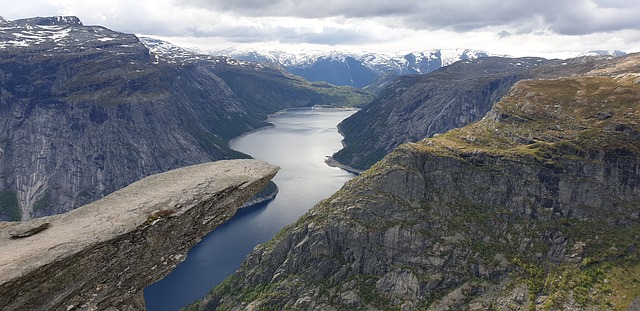
By Jo Nova
This new study pokes holes in the dogma five different ways
Credit to Kenneth Richards who found the study and discussed it at NoTricksZone
Bones in a cave inside the Arctic circle show that the world was hotter, the climate is always changing, and life adapts very well.
A special cave in far northern Norway has a a trove of thousands of old bones. They are deposited in layers that stretch back from 5,800 years ago to 13,000 years ago. And it’s been a radical change: at the start, the cave was submerged under the ocean, so the bones are mostly marine species. But a few thousand years later the weather was warm, and birds and mammals had moved in. By 6,000 years ago the researchers estimate it was the hottest part of the Holocene and 1.5°–2.4°C warmer than the modern era of 1961–1990.
After that, the cave was blocked by scree, and the bone fragments sat there seemingly undisturbed for nearly 6,000 years while the ice sheets moved and the Vikings came and went and the world cooled. Then in 1993 someone happened to build a road nearby and found the cave. Now a team have analyzed the DNA in the layers and discovered that far from being an ecological disaster, when the Earth was hotter the Arctic must have been full of life. They found lemmings, shrews, voles, hares, geese, frogs, seals, and pheasants. They were also surprised to find dogs and cats there, even though there were no humans at the time (that we know of). The DNA test couldn’t distinguish whether these were our domesticated furry friends or their wild cousins. In any case, there were species that lived there then, that don’t live there now because it’s too cold.
Some of these species are headed northward again, and small children at universities are probably being frightened and told this is “unprecedented”, but the truth is that the Holocene really was hotter than today, and some of these species were seemingly happy about that for thousands of years. The other truth is that climate change happens naturally, even without SUVs, and that species have migrated. Climate modelers have been trying to erase the Holocene period for ten years, because it was hotter than now, but CO2 levels were lower. When they are not denying it happened, they call that mismatch “the Holocene conundrum”.
Remember all the panic about animals being climate refugees forced to move because we drive cars? Well they’ve been there before.
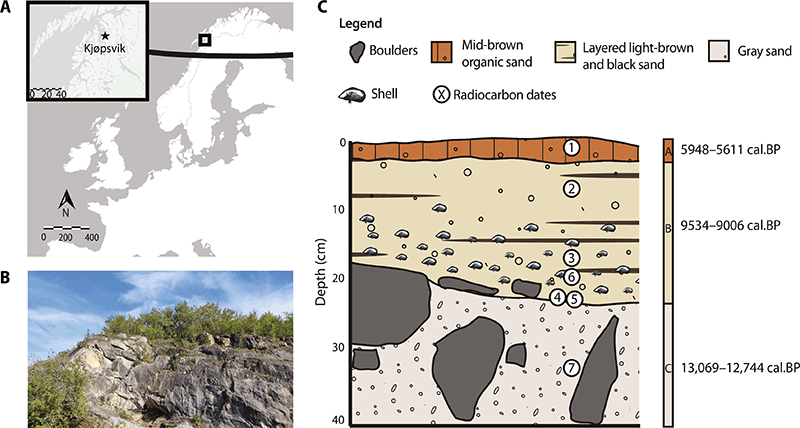
In the press release the researchers put in all the usual inappropriate warnings about how climate change is real, and this study can’t be used against the (billion dollar) climate activist industry. It just reminds us how captured science is. Let the hostages speak:
She emphasizes that what happened to the climate after the last ice age cannot be used to take away the seriousness of what is happening as a result of current anthropogenic climate change.
“But this knowledge can help us to better analyze how climate change will affect animal diversity in the future,” says Boessenkool.
But the truth seeps out anyway — the species today are just returning towards areas they lived in thousands of years ago:
The species they list from this layer [5,800 years ago] include forest birds such as grouse and a genus of fish called Seriola (amberjacks), which is also now heading north again with a warming climate.
“We see that some of the species that are moving northwards today have been here before. We know that it was warmer in the past, but we don’t have a full overview of which animal species existed this far north,” explains Boilard.
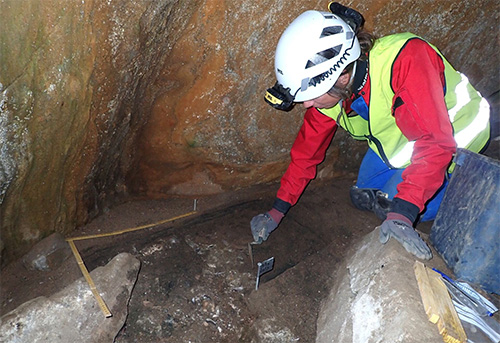 Bones and DNA are particularly well preserved in caves. Here from the excavation in Nygrotta. Credit: EvoCave Somehow freshwater fish colonized the area “immediately” after the ice retreated. Ain’t life remarkable?
The researchers also found remains of freshwater fish from a remarkably early phase.
“In the deposits dating back 9,500 years, we found remains of freshwater fish. We don’t know for sure how these fish migrated into Norway after the glaciers melted. But we see that freshwater fish arrive very early in the north, almost immediately after the ice disappeared,” says Boilard.
The changes at this one site are just extraordinary. We humans have some crazy idea that the land and oceans we see today have always been that way:
The lowest and oldest sediment layer examined was 13,000 years old. At that time, the sea level was above the cave opening and the climate was colder than today. In this layer the researchers only found fish species that are adapted to cold conditions, such as cod and ling.
Due to land shifting and ice melting the relative sea level was effectively 90 meters higher… then the ice sheet advanced again:
Layer C (13,069–12,744 cal B.P.) coincides with the Late Glacial interstadial (14.0–12.9 ka), a period of mixed climatic conditions during which the Scandinavian Ice Sheet margins retreated rapidly and the relative sea level rose to ~90 m higher than present day (35, 45). In the vicinity of Nygrotta, the ice sheet had retreated deeper into the fjord, and exclusively marine-related species recovered from the sand deposit in layer C support its interpretation as shallow marine sand and Nygrotta being submerged at the time. Shortly after the deposition of layer C, the Scandinavian Ice Sheet readvanced again in the transition to and during the early part of the Younger Dryas stadial
For the cat lovers, the researchers did get excited that they might have found the furthest north and earliest evidence of Felis Silvestris, though poor old Felis was wiped out at the end of the Holocene maximum as temperatures fell again:
If the Nygrotta samples represent wildcat (F. silvestris), then this would be remarkable, as this would be the highest latitude location for this species ever (74). The potential authentic identification of wildcats is an exciting prospect as remains across Europe are scarce (74, 75). In Fennoscandia, the species has been recorded in Sjælland, Denmark, as part of the boreal fauna dated to 9.5 ka B.P. (24). In Norway, wildcats have only been found at three sites: Vistehola [~8.5 ka B.P.; (31)], Auve [(5–4 ka B.P.; (76)], and Årdal rock shelter (4–3 ka B.P.; Archive University Museum of Bergen)—all in southern Norway approximately 850–1000 km south of Nygrotta. The last evidence of wildcats in Fennoscandia comes from the site of Næsbyholm, Denmark, and dates to 2000 cal B.P. (77–79). The species became extinct in Fennoscandia following the end of the HTM, as temperatures dropped and snow cover increased above the wildcat threshold of 20 cm over a 100-day period (75, 80). Estimates of past wildcat habitat limited their past distribution to the southwest coast of Norway (81), but our potential finding of wildcats at Nygrotta suggests that their range may have extended much further north already during the Early Holocene, at least along the coastline. Such early presence of wildcats would also be evidence for relatively low amounts of snow cover along Norwegian coastlines during this time and would suggest that the boreal pine and birch forests in Norway from 8 ka B.P. (82, 83) provided suitable habitat for this species.
It also opens the novel idea of using feral cats as a proxy for snow-cover.
And if anyone wonders if the Holocene warming was just a Norwegian thing, there are many more Holocene markers all over the world. 6,000 years ago the world was so much warmer, the Sahara was lush green and wet. Sea levels were 1 – 2 meters higher around Australia, temperatures were warmer in Greenland and in Vostok, and people saw a global wave of warmth in 6,000 boreholes drilled across 6 continents. The deepest oceans around Indonesia were 2 degrees warmer 10,000 years ago. Pacific Islands were born in the last 5,000 years as the oceans cooled and shrank. And fires were far worse 4,000 years ago in Northern Australia.
REFERENCE
Aurélie Boilard et al, (2024) Ancient DNA and osteological analyses of a unique paleo-archive reveal Early Holocene faunal expansion into the Scandinavian Arctic, Science Advances . DOI: 10.1126/sciadv.adk3032
Press Release https://phys.org/news/2024-04-ancient-dna-bones-reveal-species.html
Top Image by travel_pics from Pixabay
10 out of 10 based on 78 ratings
10 out of 10 based on 11 ratings
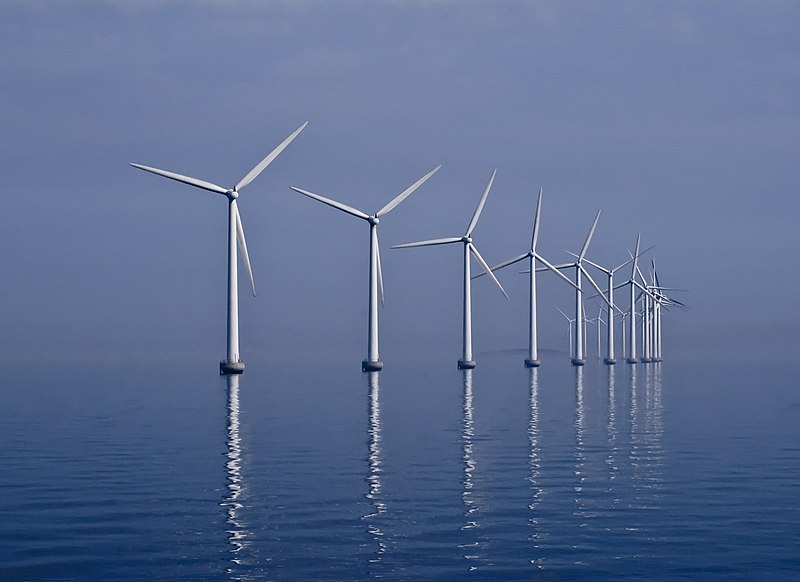
By Jo Nova
The more wind turbines we have the more useless they are
There goes those plans to cover the continental shelf with talismen to the Wind Gods.
New research shows wind turbines off the East Coast of the US could end up stealing as much as a third of the energy from other wind turbines downstream. And in some conditions, the turbulent wake they leave might stretch out 55 kilometers behind them. This effect is worst on turbines in the same “farm” but could even affect other wind farms a long way off.
The wake effect will be strongest in summer. We’ll just have to ask everyone to turn off their air conditioners then?
Scientific civilizations do this sort of research before they commit $10 trillion dollars, set up a trading scheme, and blow up the coal plants. Imagine if building a coal plant near another plant made it 30% less efficient on hot days…
Hat tip to the NetZeroWatch email list:
By Kirk Moore, WorkBoat
The researchers’ paper published March 14 in the journal Wind Energy Science suggests that offshore wind turbines off the U.S. East Coast could rob neighboring turbine arrays of wind speed and thus power generation depending on daily conditions, by more than 30%.
“Using computer simulations and observational data of the atmosphere, the team calculated that the wake effect reduces total power generation by 34% to 38% at a proposed wind farm off the East Coast,” according to the University of Colorado. ”Most of the reduction comes from wakes formed between turbines within a single farm.”
“But under certain weather conditions, wakes could reach turbines as far as 55 kilometers (34 miles) downwind and affect other wind farms. For example, during hot summer days, the airflow over the cool sea surface tends to be relatively stable, causing wakes to persist for longer periods and propagate over longer distances.”
 Figure 3Hub-height wind roses for the NYSERDA Hudson North (E05) and Hudson South (E06) floating lidars during the 1 September 2019 to 1 September 2020 period. The location of E06 is shown as the red diamond and E05 as the red triangle. The bottom row shows wind roses segregated by atmospheric stratification. Ominously, the worst power deficits in these graphs are not the black spots but the red and white ones…
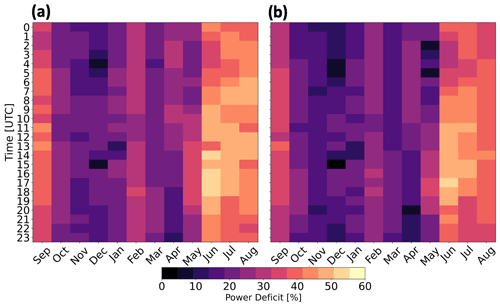 Figure 14The percentage of power loss at ONE from internal wakes at (a) TKE_0 and (b) TKE_100. First build 10,000 wind farms, then figure out how it works:
From the press release:
To better understand how the wind blows in the proposed wind farm area, Lundquist’s team visited islands off the New England coast and installed a host of instruments last December as part of the Department of Energy’s Wind Forecast Improvement Project 3. The project is a collaboration of researchers from CU Boulder, Woods Hole Oceanographic Institution and several other national laboratories.
The instruments, including weather monitors and radar sensors, will collect data for the next year or more. Previously, offshore wind power prediction models usually relied on intermittent data from ships and satellite observations. The hope is that with continuous data directly from the ocean, scientists can improve prediction models and better integrate more offshore wind energy into the grid.
As long as we try to collect wind energy, the nightmare of thousands of high voltage interconnector lines will never go away.
REFERENCE
Rosencrans et al (2024) Seasonal variability of wake impacts on US mid-Atlantic offshore wind plant power production Articles, Volume 9, issue 3 WES, 9, 555–583, 2024 https://doi.org/10.5194/wes-9-555-2024
Photo by Kim Hansen.
10 out of 10 based on 74 ratings
10 out of 10 based on 10 ratings
By Jo Nova
Good news: despite 2023 being the hottest year since Homo Erectus, there was a 17% fall in the number of 18 to 34 year olds who call “Climate change” a very serious problem. Even though there were hottest-ever-headlines month after month, the punters lost the faith.
No one is cracking champagne, because 50% of young adults still tell pollsters they think it is a “very serious problem”. But when all is said and done, at least half the generation that was drip-fed the dogma since kindergarten, can not only see through the catastrophism but they are brave enough to tell a pollster that too.
For the most part, after a few hot El Nino years, “climate fear” is back where it was in 2016 or so. Most people still want the government to solve the weather with someone else’s money. But where younger people were once much more enthusiastic about a Big Government fix than older people were, now that gap is almost closed. What was a 21% difference between those age groups is now only 2%. That’s a whopping fall in faith in the government to do something useful, or probably, a recognition that whatever the government does, it will cost too much.
Looks like young adults are learning to be cynical adults faster?
The Monmouth university group polled 804 people in late April:
The percentage of Americans between the ages of 18 and 34 who see climate change as a very serious problem has fallen by 17 points in the past three years (50%, down from 67% in 2021), compared with smaller declines among those who are 35 to 54 years old (44%, down from 48%) and those age 55 and older (44%, down from 54%).
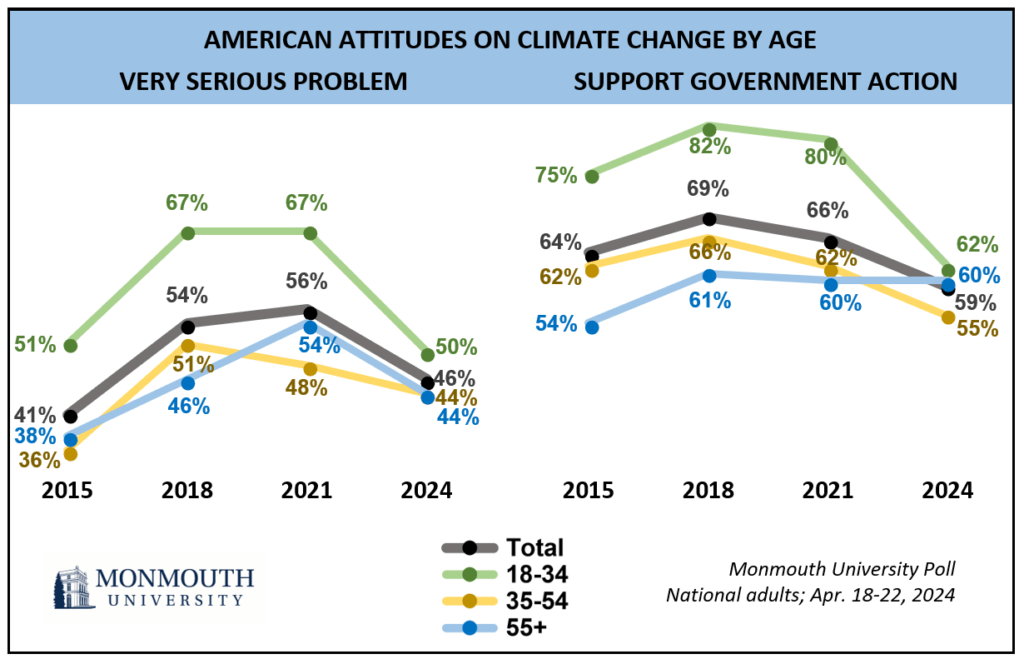
But what does “a very serious problem” even mean?
Anyone can say “it’s serious” but only 1 in 6 people can even be bothered pretending to a pollster that climate change influences their vote:
A Monmouth poll released last month found only 15% of voters view climate change as a determinative issue in how they will vote in the 2024 presidential election, ranking far lower than inflation, immigration, and abortion.
People used to lie to pollsters and say they cared and it would affect their vote, but now most don’t even pretend. In 2019 in the UK two-thirds of people agreed climate was the biggest issue facing humankind. The Guardian writers were sure that climate change would determine how most of the voters would vote, but the party promising to give them better weather lost in a landslide.
In 2015, when nearly half of US voters said climate was a “very serious problem”, other surveys showed only 3% ranked climate change as the most important issue.
If a twenty-something really believed the Antarctic ice cap was about to melt, wouldn’t it rate as a voting issue?
So let’s be clear, year after year, we see the same results. The voters don’t want to spend money on climate change and won’t change their vote, but the politicians act as though their career depends upon it, and the public are “demanding action”.
After years of surveys like this, we know the politicians know the voters don’t care, but they go and force climate action on the voters anyway. Who are they really working for? Their donors? The people who give them “jobs” after they leave office, or the people who employ their children now? Or are they working to appease “the media” — cowed into submission because someone might call them a denier if they don’t grovel before the Climate Demi-God?
Last year a survey showed more then half of the US are wondering the same question and agree that the people who really “run” the country are not known to voters.
Fully 92% of Democrat voters says they think climate change is real. (What else could they say, they’d be excommunicated from friends and family if they said anything else.) Only 51% of Republicans tell pollsters they think climate change is real. But imagine how fast that would plummet if skeptical professors were interviewed on TV, and half of Republican politicians spoke for half the Republican voters?
Only a third of voters agree with the UN Experts that climate change is mainly a human driven thing
Despite the UN experts being 97% certain, only one third of voters completely agree with them. That’s really quite astounding.
Public opinion remains mixed on the degree to which human behavior contributes to change in the climate. Just over one-third (34%) say climate change is caused mainly by human activity while 31% say human activity and natural changes in the environment play equal roles. Another 7% put climate change down mainly to natural causes, with the remainder saying climate change is not happening (23%) or are not sure if it is happening (4%). Just over half of Americans (51%) say there is still time to prevent the worst effects of climate change while just 17% say it is too late.
After thirty years of scientific and media purity, only one third think climate change is “mostly human”. Another third think the UN must be exaggerating, and the last third know the UN is wrong.
REFERENCE
The Monmouth University poll, Climate Change Concerns Dip, May 6th, 2024
9.9 out of 10 based on 81 ratings
8.8 out of 10 based on 18 ratings
By Jo Nova
They’re not even pretending anymore
Hands up who thinks Mark Zuckerberg lies awake at night worrying that climate change will destroy Pacific islands? This is a man who fights “climate misinformation online” but destroys ecosystems on weekends…
Hypocrisy is thy name: He hopes you will use his virtual reality glasses so you can visit friends online without using a car, a boat or a plane, but he’ll visit his own friends in his $300 million mega-yacht.
In the world we thought we lived in, this would have made him a laughing stock on MSN et al, and pretty much rule him out from grandstanding on climate change, or ever being invited to the UN struggle sessions again, but we know the prostitutes for climate grants will smile and fawn, and so will the politicians, and so will the media.
But all over the internet, people are mocking him: “Don’t you love it when they lecture us about our CO2 emissions from the private jet or their super yacht?”
Hindustan Times
Mark Zuckerberg’s latest status update screams real-world billionaire choice: a $300 million superyacht. With an estimated net worth of US$180 billion per Forbes, one of the world’s richest men and founder of Meta dropped a whopping sum on a superyacht he calls Launchpad.
With a gross tonnage of 5,000 gross tons, the yacht can cruise at speeds of up to 24 knots, providing an epic cruising experience for the billionaire owner. It currently holds the 45th position as being one of the world’s largest yachts. The beast also has a helipad designed in case the Meta owner changes his mind and wants to catch a sudden flight.
Still, this is hardly out of character. Zuckerberg was caught burning $158,000 in fuel in his private jet in just two months in 2021. But the usual suspects (who say they care about CO2 emissions) seem more concerned with silencing people than with his emissions:
In March 2021, 13 environmental groups, including the Union of Concerned Scientists and Greenpeace, sent Zuckerberg a letter calling on him to commit to monitoring climate disinformation and provide more transparency about the scale of the problem.
Will Greenpeace protest the yacht? The words of an old geologist on twitter surely can’t misinform more people than a billionaire who buys a maxi-yacht. And if Zuckerberg doesn’t give a damn about climate change, why was he so happy to silence people?
Don’t just use this to squeeze Zuckerberg, any serious greenie journalist or climate charity group needs to explain why they haven’t protested, written him a letter, and turned down his party invitations. Make them pay…
9.9 out of 10 based on 113 ratings
8.7 out of 10 based on 16 ratings

By Jo Nova
JP Morgan, BlackRock drop out of climate banker cabal, and admit the Net Zero transition is “delayed”
In February three of the four largest financial houses in the world, left the giant financial cabal called“Climate 100+” (the fourth one left a year ago). BlackRock, JP Morgan and State Street all parted ways with the billionaire-club of philanthropists trying to bully the world into buying their own renewables. In the two months since then, two of their CEO’s have put out “letters to shareholders” predicting how the transition is going to be slower and harder and how we still need fossil fuels.
Suddenly everyone sounds like an energy skeptic.
There are lots of reasons for this shift:
1: US Republican States are pointing the “AntiTrust” gun at the billionaire banker club because it looks exactly like a monopolistic cabal doing its best to collude to reduce competition. The States are also firing up the fiduciary duty canon. Hence the bankers not only want to back away from the cabal, they want to sound like bankers that care about investing their clients funds.
2. The renewables bubble is deflating fast, and the CEO’s can see what’s coming. Think of their renewable energy passion a few years ago as a pump-n-dump scheme and it all makes more sense. Right now smart bankers are smoothing the exit ramp out of the bubble they created and hoping no one notices how wrong all their previous statements were.
3. Maybe there’s a point where smart banker billionaires realize they don’t want their own homeland to hit the skids. They’ve all made a fortune in the last four years, but who wants that fifth private jet if there is no homeland to come home too? Jamie Dimon astonished people when came out in January saying Trump’s policies were “kinda right”. Billionaires might want to visit China, but they don’t want to live there. And as I said at the time, maybe the wake up call was when the paratroopers-of-death dropped into a democracy and the Ivy league started cheering them on.
4. And besides, Trump might even win.
How times have changed
A year ago the CEO of the JP Morgan was calling for forced property seizure in a climate emergency:
6 April 2023 10:29 GMT, Recharge
One of the world’s highest-profile bankers – JP Morgan Chase CEO Jamie Dimon – said the US government should consider seizing private property to boost the number of green energy projects coming through the pipeline. Dimon told the bank’s shareholders that availability of wind and solar projects needs to be accelerated urgently as “the window for action to avert the costliest impacts of global climate change is closing”.
This year we need a reality check:
By Irina Slav, OilPrice, April 19th, 2024
Inflation, interest rates, and wars may well delay the energy transition by quite a long time, JP Morgan has warned in a call for “a reality check” on its shift from hydrocarbons to alternatives.
…the bank’s head of global energy strategy, Christyan Malek, … forecasts that governments will dial down the push to transition from oil and gas to wind and solar as their financial resources dwindle.
Jamie Dimon’s Letter to Shareholders in 2024, is a 30,000 word 70 page letter. Despite being a small book it mentions “climate” just 13 times. He’s now more concerned about China (18 mentions) and uses the word military 24 times. He criticizes the Inflation Reduction Act because it angered all the allies of the US and he argues the US should dig up gas and sell it for political gain as well as the money:
Trade is realpolitik, and the recent cancellation of future liquified natural gas (LNG) projects is a good example of this fact. The projects were delayed mainly for political reasons — to pacify those who believe that gas is bad and that oil and gas projects should simply be stopped. This is not only wrong but also enormously naïve. One of the best ways to reduce CO2 for the next few decades is to use gas to replace coal. When oil and gas prices skyrocketed last winter, nations around the world — wealthy and very climate-conscious nations like France, Germany and the Netherlands, as well as lower-income nations like Indonesia, the Philippines and Vietnam that could not afford the higher cost — started to turn back to their coal plants. This highlights the importance of safe, secure and affordable energy. Second, the export of LNG is a great economic boon for the United States. But most important is the realpolitik goal: Our allied nations that need secure and affordable energy resources, including critical nations like Japan, Korea and most of our European allies, would like to be able to depend on the United States for energy. This now puts them in a difficult position — they may have to look elsewhere for such supplies, turning to Iran, Qatar, the United Arab Emirates or maybe even Russia. We need to minimize anything that can tear at our economic bonds with our allies.
The strength of our domestic production of energy gives us a “power advantage” — cheaper and more reliable energy, which creates economic and geopolitical advantages.
Meanwhile Larry Fink, CEO of BlackRock, the largest asset fund in the world, has undergone a very similar transformation. In 2021, he was raving how the existential crisis and how this was the beginning of a long and rapidly accelerating transition:
I believe that the pandemic has presented such an existential crisis – such a stark reminder of our fragility – that it has driven us to confront the global threat of climate change more forcefully and to consider how, like the pandemic, it will alter our lives. It has reminded us how the biggest crises, whether medical or environmental, demand a global and ambitious response.
…I believe that this is the beginning of a long but rapidly accelerating transition – one that will unfold over many years and reshape asset prices of every type. We know that climate risk is investment risk.
But now, after the bubble came and went, now he’s telling us energy security is just as important as the climate crisis:
By Eric Johnston, March 27, 2024, The Australian Business Review
One of the world’s most influential investors has said the switch is on to “energy pragmatism” that recognises energy security is just as important in the move to net zero. Larry Fink of the $US10 trillion ($15.3 trillion) BlackRock has acknowledged the world will need to rely on oil and gas “for years to come” through the uneven energy transition.
… his letter … which runs to almost 30 pages, only mentions climate change in passing and the discussion is limited to strategies under way in the energy transition.
Larry Fink’s letter to investors in 2024 didn’t even mention ESG.
These are the levers of power you see shifting. BlackRock manages $10 trillion dollars in assets, and according to Jamie Dimon’s letter, JP Morgan was managing assets of $7.6 trillion. When these men write long letters, Wall Street studies them.
A lot of people have suddenly started to say in April that “we always knew the transition would be expensive” — the phase change is following the bankers.
10 out of 10 based on 82 ratings
8.2 out of 10 based on 15 ratings
7.7 out of 10 based on 26 ratings
|
JoNova A science presenter, writer, speaker & former TV host; author of The Skeptic's Handbook (over 200,000 copies distributed & available in 15 languages).

Jo appreciates your support to help her keep doing what she does. This blog is funded by donations. Thanks!


 Follow Jo's Tweets
Follow Jo's Tweets To report "lost" comments or defamatory and offensive remarks, email the moderators at: support AT joannenova.com.au
Statistics
The nerds have the numbers on precious metals investments on the ASX
|

























Recent Comments